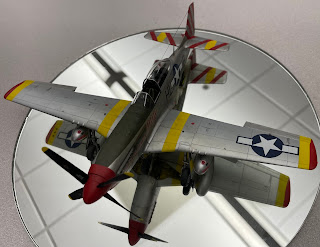I'll admit, I'm a fan of the K.I.S.S. principle. K.I.S.S is an abbreviation for "Keep It Simple, Silly", but the final "S" can signify various other words not fit to print here.
Rattle cans are probably the hallmark K.I.S.S. product with regards to modeling. It's easy. Push a button, paint comes out, and suddenly your modeling bench is covered in red paint. What's not to like? Since I reentered the modeling hobby ten years ago, however, spray cans have been eschewed in favor of airbrush applied finishes. You just can't beat the control an airbrush gives you in your paint or clearcoat finish.
One of the products that I do like to use in spray can form is Dull Cote. I hadn't been brave enough to attempt to airbrush this product, even knowing there was a bottled version intended simply for manual brushing. This evening, after reading endless internet posts on the topic and watching a few YouTube videos, I decided to give it a try. I had an old bottle of the stuff languishing in my modeling file cabinet. Out it came.
The appealing thing about Dull Cote in the bottle is that it's lacquer based. The chief advantage of this is that it will dry very quickly. While the spray can version is lacquer based also, you cannot vary the proportion of the Dull Cote to the thinner, which in this case obviously is lacquer thinner. With an airbrush, you can thin the Dull Cote in order to better control the spray, which increases the odds of getting an optimum application on the model.
With a bit of intrepidity, I poured some of the Dull Cote into a glass baby food jar. Using the recommended proportion of 1:1 off the 'net, I thinned it with lacquer thinner until it looked right. Yep, I eyeballed it. Given the "hotness" of the medium, though, I figured by controlling the airbrush distance and airflow I could mediate any mistakes in thinness.
Using the group build accessories I built, I began to spray. I was instantly amazed in how quickly the Dull Cote dried. With just the right amount of throttle on the airbrush, the mixture would hit the parts wet and dry within seconds. It was doing it as I watched! Even more brilliant, the high gloss imparted by a coat of Future Floor Wax I'd used earlier disappeared as I swept back and forth across the part. It was as if I was using a magic wand to get a perfectly matte surface. The surface was
dead flat.
Needless to say, despite the hassle of fumes and cleanup (I usually use acrylic products due to their ease of cleanup), I believe I may convert to airbrushing this product. I simply can't argue with the results. I can't wait to try this method of flat coat delivery on my next armor or aircraft model. Check out the pic:










































